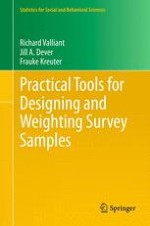2013 | OriginalPaper | Chapter
13. Basic Steps in Weighting
Authors : Richard Valliant, Jill A. Dever, Frauke Kreuter
Published in: Practical Tools for Designing and Weighting Survey Samples
Publisher: Springer New York
Activate our intelligent search to find suitable subject content or patents.
Select sections of text to find matching patents with Artificial Intelligence. powered by
Select sections of text to find additional relevant content using AI-assisted search. powered by
